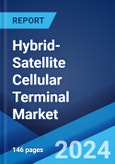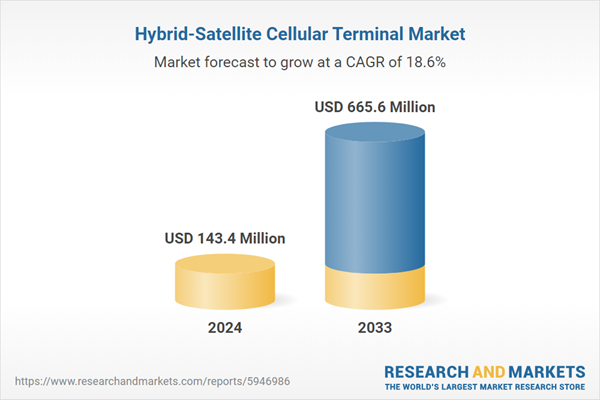The global hybrid-satellite cellular terminal market size reached USD 143.4 Million in 2024. Looking forward, the publisher expects the market to reach USD 665.6 Million by 2033, exhibiting a growth rate (CAGR) of 17.67% during 2025-2033. The market is experiencing robust growth driven by the rising demand for reliable communication in emergencies, increasing reliance of mobile workforce and transportation systems on hybrid-satellite cellular terminals, and the expanding Internet of Things (IoT) applications, which require robust and widespread connectivity.
Expanding IOT Applications: The rapid proliferation of the Internet of Things (IoT) applications is propelling market growth, as these devices require seamless connectivity across various environments.
Industry Applications: The market is experiencing high demand from diverse industries, including telecommunications, agriculture, maritime, and energy, seeking robust and resilient communication solutions.
Geographical Trends: North America leads the market, propelled by its extensive adoption of hybrid-satellite cellular terminals in rural and remote regions, along with government initiatives supporting connectivity expansion.
Competitive Landscape: The market is characterized by intense competition with key players focusing on innovation and strategic partnerships to gain a competitive edge.
Challenges and Opportunities: While the market faces challenges, such as spectrum allocation issues and regulatory hurdles, it also offers significant opportunities in addressing the digital divide and expanding connectivity in underserved regions.
Future Outlook: The future of the hybrid-satellite cellular terminal market looks promising, with potential growth in emerging markets, advancements in satellite technology, and the continued integration of satellite and cellular networks for enhanced connectivity solutions.
Rapid proliferation of the Internet of Things (IoT)
The rapid proliferation of the Internet of Things (IoT) is another key factor propelling the global hybrid-satellite cellular terminal market forward. In today's interconnected world, industries such as agriculture, transportation, and energy increasingly rely on IoT devices to collect data, enhance efficiency, and enable real-time decision-making. IoT applications span vast and diverse geographical areas, including remote regions where traditional cellular networks may not reach reliably. This necessitates the deployment of hybrid-satellite cellular terminals to ensure continuous and resilient connectivity, even in remote and challenging environments, thus catalyzing market growth. These terminals offer a critical link in the IoT ecosystem, facilitating seamless data transmission from sensors and devices to centralized platforms. As the IoT landscape continues to expand, driven by escalating demands for smart agriculture, efficient logistics, and energy management, the market for hybrid-satellite cellular terminals is poised for significant growth, positioning itself as an indispensable enabler of IoT-driven innovation and efficiency across multiple sectors.
The market research report has provided a comprehensive analysis of the competitive landscape. Detailed profiles of all major companies have also been provided.
Hybrid-Satellite Cellular Terminal Market Analysis:
Market Growth and Size: The market is witnessing stable growth, driven by the increasing demand for reliable communication solutions in remote and underserved areas.Expanding IOT Applications: The rapid proliferation of the Internet of Things (IoT) applications is propelling market growth, as these devices require seamless connectivity across various environments.
Industry Applications: The market is experiencing high demand from diverse industries, including telecommunications, agriculture, maritime, and energy, seeking robust and resilient communication solutions.
Geographical Trends: North America leads the market, propelled by its extensive adoption of hybrid-satellite cellular terminals in rural and remote regions, along with government initiatives supporting connectivity expansion.
Competitive Landscape: The market is characterized by intense competition with key players focusing on innovation and strategic partnerships to gain a competitive edge.
Challenges and Opportunities: While the market faces challenges, such as spectrum allocation issues and regulatory hurdles, it also offers significant opportunities in addressing the digital divide and expanding connectivity in underserved regions.
Future Outlook: The future of the hybrid-satellite cellular terminal market looks promising, with potential growth in emerging markets, advancements in satellite technology, and the continued integration of satellite and cellular networks for enhanced connectivity solutions.
Hybrid-Satellite Cellular Terminal Market Trends:
Rising demand for rural connectivity
Rural connectivity demand is a major driver fueling the growth of the hybrid-satellite cellular terminal market. Inhabitants of rural and remote regions frequently encounter challenges due to the limited reach of traditional cellular networks. This digital divide hinders their access to essential services, information, and economic opportunities. Hybrid-satellite cellular terminals emerge as a vital solution to bridge this connectivity gap effectively. By seamlessly integrating satellite and cellular technologies, they offer consistent and reliable communication services even in the remotest corners of the world. This has a profound impact on numerous sectors, including agriculture, healthcare, education, and emergency response. As global urbanization continues, the demand for rural connectivity intensifies, making hybrid-satellite cellular terminals a critical enabler for equitable access to digital resources. Hybrid-satellite cellular terminals play a pivotal role in narrowing the digital divide, empowering rural communities with the connectivity necessary for social and economic progress. As a result, this driver underlines the industry’s significance in addressing the connectivity needs of underserved populations and fostering inclusive development, thus stimulating the market growth.Rapid proliferation of the Internet of Things (IoT)
The rapid proliferation of the Internet of Things (IoT) is another key factor propelling the global hybrid-satellite cellular terminal market forward. In today's interconnected world, industries such as agriculture, transportation, and energy increasingly rely on IoT devices to collect data, enhance efficiency, and enable real-time decision-making. IoT applications span vast and diverse geographical areas, including remote regions where traditional cellular networks may not reach reliably. This necessitates the deployment of hybrid-satellite cellular terminals to ensure continuous and resilient connectivity, even in remote and challenging environments, thus catalyzing market growth. These terminals offer a critical link in the IoT ecosystem, facilitating seamless data transmission from sensors and devices to centralized platforms. As the IoT landscape continues to expand, driven by escalating demands for smart agriculture, efficient logistics, and energy management, the market for hybrid-satellite cellular terminals is poised for significant growth, positioning itself as an indispensable enabler of IoT-driven innovation and efficiency across multiple sectors.
Increasing demand for seamless communication during emergencies
Disaster preparedness and emergency response represents the primary factor supporting the growth of the hybrid-satellite cellular terminal market. The imperative need for uninterrupted communication during crises, natural disasters, and emergency situations has accelerated the adoption of these terminals by governments, organizations, and first responders worldwide. In times of calamity, conventional communication networks often face disruptions, making it imperative to have resilient alternatives in place. Hybrid-satellite cellular terminals play a pivotal role in ensuring continuous connectivity, allowing emergency personnel to coordinate efforts, deliver aid, and save lives efficiently. Their ability to provide reliable communication in remote, disaster-stricken areas is invaluable, as is their capacity to establish communication hubs rapidly in areas with damaged infrastructure. As climate-related disasters and unforeseen emergencies become more frequent, the demand for these terminals continues to rise, underscoring their significance as an essential tool in disaster preparedness and response efforts. This, in turn, contributes significantly to the overall growth and relevance of the market.Hybrid-Satellite Cellular Terminal Industry Segmentation:
The publisher provides an analysis of the key trends in each segment of the market, along with forecasts at the global, regional, and country levels for 2025-2033. Our report has categorized the market based on platform, frequency band, service, and end user.Breakup by Platform:
- Land
- Maritime
- Aeronautical
Breakup by Frequency Band:
- S-Band Terminal
- Ka-and Ku-Band Terminal
Ka-and Ku-band terminal holds the largest share in the industry
A detailed breakup and analysis of the market based on the frequency band have also been provided in the report. This includes S-band and Ka-and Ku-band terminals. According to the report, Ka-and Ku-band terminal accounted for the largest market share.Breakup by Service:
- Video and Voice Service
- Data Service
- Tracking and Monitoring
Breakup by End User:
- Oil and Gas
- Media and Entertainment
- Defense
- Aviation
- Automotive
- Logistics and Transportation
- Telecommunication
Defense represents the leading end user segment
A detailed breakup and analysis of the market based on the end user have also been provided in the report. his includes oil and gas, media and entertainment, defense, aviation, automotive, logistics and transportation, and telecommunication. According to the report, defense accounted for the largest market share.Breakup by Region:
- North America
- United States
- Canada
- Asia Pacific
- China
- Japan
- India
- South Korea
- Australia
- Indonesia
- Others
- Europe
- Germany
- France
- United Kingdom
- Italy
- Spain
- Russia
- Others
- Latin America
- Brazil
- Mexico
- Others
- Middle East and Africa
North America leads the market, accounting for the largest hybrid-satellite cellular terminal market share
The market research report has also provided a comprehensive analysis of all the major regional markets, which include North America (the United States and Canada); Asia Pacific (China, Japan, India, South Korea, Australia, Indonesia, and others); Europe (Germany, France, United Kingdom, Italy, Spain, Russia, and others); Latin America (Brazil, Mexico, and others); and the Middle East and Africa. According to the report, North America accounted for the largest market share.The market research report has provided a comprehensive analysis of the competitive landscape. Detailed profiles of all major companies have also been provided.
Some of the key players in the market include:
- EchoStar Mobile Ltd. (EchoStar Corporation)
- Kymeta Corporation
- OQ Technology
Key Questions Answered in This Report:
- How has the global hybrid-satellite cellular terminal market performed so far, and how will it perform in the coming years?
- What are the drivers, restraints, and opportunities in the global hybrid-satellite cellular terminal market?
- What is the impact of each driver, restraint, and opportunity on the global hybrid-satellite cellular terminal market?
- What are the key regional markets?
- Which countries represent the most attractive hybrid-satellite cellular terminal market?
- What is the breakup of the market based on the platform?
- Which is the most attractive platform in the hybrid-satellite cellular terminal market?
- What is the breakup of the market based on the frequency band?
- Which is the most attractive frequency band in the hybrid-satellite cellular terminal market?
- What is the breakup of the market based on the service?
- Which is the most attractive service in the hybrid-satellite cellular terminal market?
- What is the breakup of the market based on the end user?
- Which is the most attractive end user in the hybrid-satellite cellular terminal market?
- What is the competitive structure of the market?
- Who are the key players/companies in the global hybrid-satellite cellular terminal market?
Table of Contents
1 Preface3 Executive Summary12 Value Chain Analysis14 Price Analysis
2 Scope and Methodology
4 Introduction
5 Global Hybrid-Satellite Cellular Terminal Market
6 Market Breakup by Platform
7 Market Breakup by Frequency Band
8 Market Breakup by Service
9 Market Breakup by End User
10 Market Breakup by Region
11 Drivers, Restraints, and Opportunities
13 Porters Five Forces Analysis
15 Competitive Landscape
List of Tables
Companies Mentioned
- EchoStar Mobile Ltd. (EchoStar Corporation)
- Kymeta Corporation
- OQ Technology
Methodology

LOADING...
Table Information
| Report Attribute | Details |
|---|---|
| No. of Pages | 143 |
| Published | March 2025 |
| Forecast Period | 2024 - 2033 |
| Estimated Market Value ( USD | $ 143.4 Million |
| Forecasted Market Value ( USD | $ 665.6 Million |
| Compound Annual Growth Rate | 18.6% |
| Regions Covered | Global |
| No. of Companies Mentioned | 3 |









